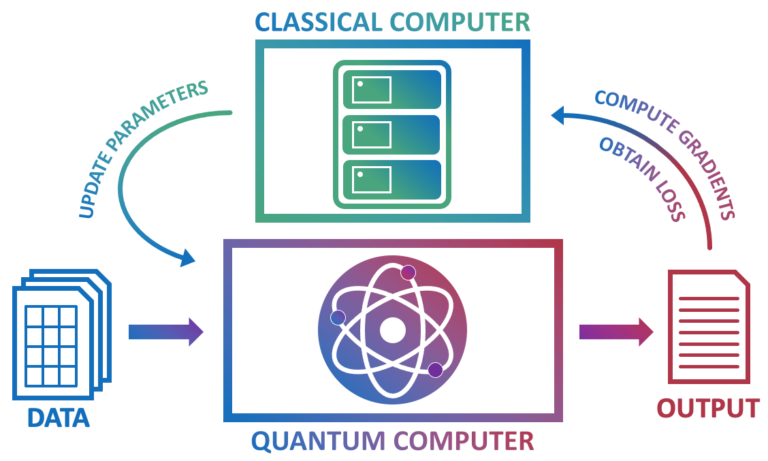Quantum computers for energy markets
Forecasting and prediction
In the past energy production was usually centralized and energy was transported in one direction. A big power plant outside the city, usually a coal or nuclear power plant produced energy for the whole city and huge power lines transported the energy to the consumers in the city.
This paradigm changed already and will change more radically. Due to climate change renewable energies like wind and solar are going to produce a majority of the energy. These smaller power plants will produce energy over a more distributed area. Sometimes energy needs to be transported many hundred of kilometers. For example from offshore wind parks.
Also wind and solar power plants only produce energy when wind is blowing or sun is shining. If wind starts to blow within a few minutes the energy output suddenly increases rapidly. Also appearance of dark clouds have a huge impact on solar power production. This mechanism has a huge impact on energy transportation. The electricity grid needs to be able to cope with very different production levels.
Therefore grid operators need to calculate power plant production schedules. Conventional power plants like gas turbines can be switched on, off or regulated to a desired level of energy production. But renewable power plants like wind turbines and solar plants depend on weather conditions. When sun is not shining and wind is not blowing the power out put is low or even zero.
This leads to the immediate requirement to forecast energy production on the producer side.

Prediction of power production depending on weather conditions
On the producer side energy supply depends heavily on weather conditions like irradiance, temperature, wind speed etc. For solar plants irradiance is one of the most important features. But also the angle in which the sun is shining on the solar panels. Usually sensors close the a solar plant collect these data. This data can now be used to forecast power supply. Machine learning methods can be used to learn the correlations of historic sensors data points and the produced energy. This can be done using traditional methods like regression or decision trees (e.g. xgboost) or more advanced neural networks (e.g. long-short term memory, recurrent neural networks or multilayer perceptrons). Also quantum neural networks can be used to predict power output, which is used in our latest work: https://github.com/JoSQUANTUM/pygrnd/blob/main/notebooks/load_forecasting.ipynb
The results are less competitive compared to classical multilayer perceptrons and require very long training times. But the quantum neural network requires only 5 qubits and 45 trainable parameters which can be trained using quantum computing simulator frameworks like pennylane or qiskit.
The approach shows a way of how to use quantum machine learning and the software library pygrnd brings a framework for prediction and classification.

Forecasting of power consumption
Also on the consumption side, electric mobility and electrification of the heating systems introduce rapid changes in energy demand levels. This high volatility of electric current and voltage has impact in the grid frequency and therefore on stability. In Europe grids operate at 50 Hz and even small drops can damage electric devices in households, factories and commercial buildings.
This leads to the immediate requirements to forecast energy demand on the consumer side. When people consume energy, charge their electric vehicles and heat their flats and houses, the electric energy needs to be predicted.
The relevant parameter that is forecasted is usually called “load” and depends on the power requirements from people, machines, electric vehicles, heat pumps etc. People usually turn on heating when the outside temperature drops below certain threshold. In commercial buildings people need electricity for light, machines and computers during working hours and less during weekends and holidays. Commercial buildings with big glass fronts get heated up more quickly if the sun radiates towards the glass front, so the energy consumption is somehow correlated with the angle of the sun.
These individual parameters, called features can be used to provide very accurate forecasts for the energy demand.
In the following picture the results of this very first naive quantum neural network for the residual load forecasting use case is shown

Software for grid operators
Accurate forecasts for grid operators are crucial to calculate power plant schedules that are usually submitted to power exchanges to calculate energy prices. The predictions can be used to feed global optimization tasks like the Unit Commitment Problem, see research project EnerQuant (https://enerquant.gitlab.io/website/).
Tools for prosumers
Modern buildings will turn from consumer only into prosumers. This is a new word for grid nodes that consume energy and also produce energy with solar panels on top of the buildings. Building operators can sell energy on power exchanges when the produced energy is higher than the consumed energy. Another approach can be to add storage devices like batteries to store energy when it is produced and feed energy to the grid when energy prices are high. This adds value to grid stability and increases financial incentives for modern buildings.
JoS QUANTUM tools & services
We provide services around forecasting energy demand and supply. Discuss with us new business models and opportunities during the time of energy transition.
Contact us at contact@jos-quantum.de
